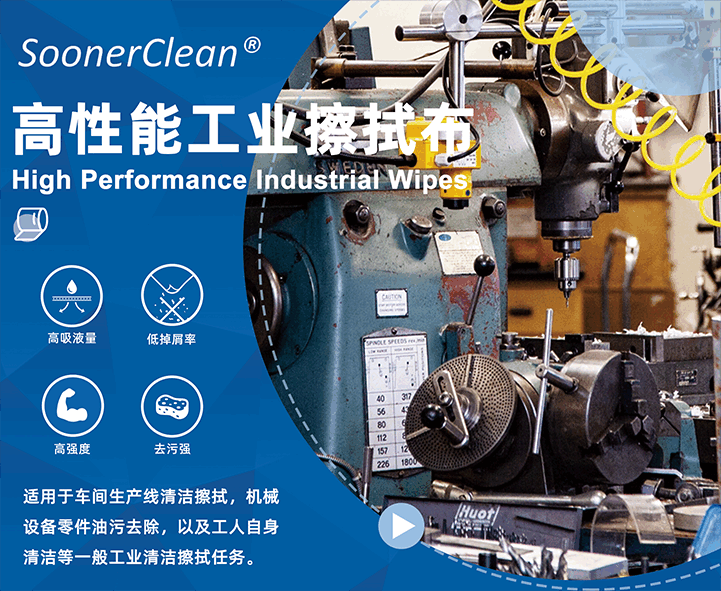Still struggling with stubborn oil stains that won't come off completely?
Worried about scratches and micro-marks left on equipment surfaces during cleaning?
A seemingly ordinary spunlace nonwoven fabric is the key to solving these problems. But why this one in particular? How should industrial-grade cleaning choose the right spunlace nonwoven fabric?
Industrial Cleaning Challenges: The Fatal Shortcomings of Ordinary Wiping Materials
Fibre Residue Nightmare: Low-quality wiping cloths shed fibres and particles, contaminating precision instruments or cleaned surfaces, leading to long-term issues.
Insufficient Strength: Repeated wiping can cause tears, especially when cleaning metal burrs or rough surfaces.
Poor Chemical Resistance: Exposure to strong cleaning agents or solvents can cause the material to break down, losing its cleaning ability and even contaminating workpieces.
Low Liquid Absorption Efficiency: Slow absorption of oil and water, with limited capacity, increases cleaning time and consumable costs.
Spunlace Non-Woven Fabric: The ‘Hardcore’ Solution for Industrial Cleaning
The hydroentanglement process uses high-pressure water jets to intertwine fibres, imparting unique properties to the non-woven fabric, making it perfectly suited for demanding industrial environments:
Exceptional strength and durability
The high-pressure hydroentanglement process significantly enhances the bonding strength between fibres, giving them ultra-high tensile strength and abrasion resistance. When repeatedly wiping metal components, removing stubborn oil stains, or grinding paste, it does not easily tear or pill, significantly reducing replacement frequency and lowering overall cleaning costs.
Core value: industrial-grade durability, tear-resistant spunlace fabric, and reduced cleaning material costs
True ‘zero residue’ cleaning
The tightly intertwined fibres and smooth, flat surface minimise fibre shedding or dust generation during wiping. This is critical for cleaning precision instruments, optical components, semiconductor equipment, and surfaces requiring ‘absolute cleanliness’ before coating, preventing secondary contamination.
Outstanding liquid absorption and retention capabilities
The unique open three-dimensional structure of spunlace fabric enables rapid absorption and retention of large amounts of liquid (oil, water, coolant, chemical solvents), effectively preventing cleaning liquid from dripping and causing secondary contamination or waste. The high absorption rate significantly improves cleaning efficiency per use.
Excellent chemical corrosion resistance
Spunlace fabric made from high-quality polyester (PET) or blended fibres can withstand the corrosion of various common industrial cleaning agents and solvents (such as alcohol, diluents, weak acid and weak alkali solutions), maintaining structural integrity and stable cleaning performance.
Gentle cleaning, protecting equipment surfaces
With a uniform and soft texture, it effectively prevents scratching of precision equipment surfaces, coatings, or polished surfaces during cleaning. It is the ideal choice for achieving the perfect balance between ‘high-efficiency cleaning’ and ‘zero damage.’
How to select industrial equipment cleaning-specific spunlace non-woven fabric?
Not all spunlace fabrics are suitable for industrial applications! The key lies in the parameters:
GSM (grams per square metre): Commonly used for industrial cleaning: 70gsm - 120gsm. Higher GSM typically means greater thickness, liquid absorption capacity, and strength, suitable for heavy soiling; lower GSM is softer and more economical, suitable for precision cleaning or light soiling.
Material:
100% polyester (PET): High strength, abrasion resistance, and excellent chemical resistance (especially resistant to weak acids and alkalis), the preferred choice for general use.
Polyester-viscose blend: Enhances absorbency and softness, suitable for applications requiring better hydrophilicity.
Thickness and loft: Affect liquid absorption speed and capacity; select based on the type and quantity of cleaning solution required.
Certifications: Special industries (e.g., food, pharmaceutical, electronics) should verify compliance with relevant cleanliness certifications such as ISO Class, IRAM, DIN, etc.
Real-world industrial application value highlighted
Automotive manufacturing: Cleaning engine components, transmissions, body panels, oil stains, and polishing compounds, ensuring residue-free surfaces for spray coating/assembly quality.
Machine shop: Wiping machine tool guides, removing cutting fluids and metal debris, protecting equipment precision.
Electronics and semiconductor industry: Clean circuit boards, precision components, and LCD screens to eliminate the risk of dust and fibre contamination.
Energy and power industry: Maintain turbines, transformers, and precision control cabinets, with resistance to oil stains and specific solvents.
Food and beverage equipment maintenance: Use food-grade certified spunlace nonwoven fabric to clean filling lines and mixing tanks, ensuring safety and hygiene.
Why is it worth being your top choice?
When a single spunlace non-woven fabric can simultaneously address the four major pain points of industrial cleaning—residue, equipment damage, low efficiency, and rising costs—it is no longer just a consumable item. Instead, it becomes a key component in ensuring smooth production, stable quality, and long-term equipment operation. Choosing a professional spunlace non-woven fabric that truly meets industrial standards is a wise investment in upgrading your cleaning process.


